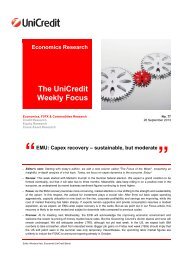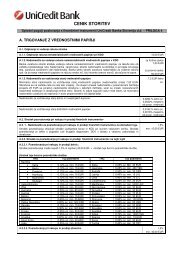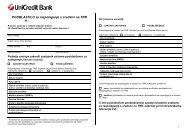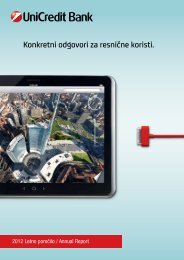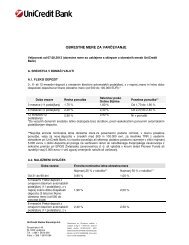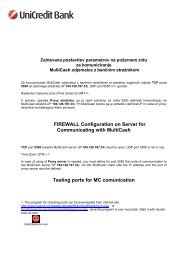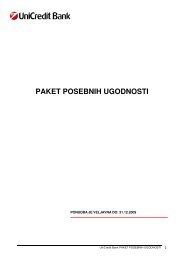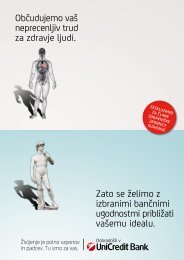Letno poroÄilo 2009.pdf - UniCredit Banka Slovenija dd
Letno poroÄilo 2009.pdf - UniCredit Banka Slovenija dd
Letno poroÄilo 2009.pdf - UniCredit Banka Slovenija dd
- No tags were found...
You also want an ePaper? Increase the reach of your titles
YUMPU automatically turns print PDFs into web optimized ePapers that Google loves.
Risk ReportRisk ReportThe principal tool used to measure and control market risk exposures is Value at Risk (VaR). VaR is the estimated loss that will arise on aspecific portfolio over a specified period of time (holding period) from an adverse market movement with a specified probability (confidencelevel). VaR for internal risk measurement is based on a one-day holding period and a confidence interval of 99 %. Besides VaR, the presentvalue of the basis point (pvbp) and credit spread basis point are calculated. Basis point limits per currency and maturity band, basis pointsums per currency and/or per maturity segment (total of absolute basis point values) and credit spread basis point limit are used for riskmanagement.Other factors of equal importance are stress-oriented volume and position limits. A<strong>dd</strong>itional elements of the limit system are loss-warninglevel limits. Monitoring income trends by means of stop-loss limits provide an early indication of any accumulation of position losses.Regular stress scenario calculations complement the information provided to ALCO and the Management Board. Such stress scenarios arebased on assumptions of extreme movements in individual market risk parameters. <strong>UniCredit</strong> <strong>Banka</strong> <strong>Slovenija</strong> d.d. analyses the effect of thesefluctuations and a liquidity disruption in specific products and risk factors on the Bank's results and net asset position.These assumptions of extreme movements are dependent on currency and liquidity and are set by the Bank in close cooperation with theStrategic Risk Management unit of <strong>UniCredit</strong> Bank Austria AG, Vienna on a discretionary basis. The results of these stress tests are taken intoaccount in establishing and reviewing limits.In a<strong>dd</strong>ition to the risk model results, income data from market risk activities are also determined and communicated on a daily basis. Thesedata are presented over time and compared with current budget figures. Reporting covers the components reflected in IFRS-based net incomeand the marking to market of all investment positions regardless of their recognition in the IFRS-based financial statements (‘total return’).In order to check the market conformity of deals, <strong>UniCredit</strong> <strong>Banka</strong> <strong>Slovenija</strong> d.d. uses the ‘MARCONIS’ system, which was developed by<strong>UniCredit</strong> Bank Austria AG, Vienna. ‘MARCONIS’ reviews completely and systematically the market conformity of each treasury transaction.Both in 2009 and in 2008, there were no deals concluded which were finally classified as not market conform.INTEREST RATE, FOREIGN EXCHANGE, EQUITY AND SPREAD RISKThe results of the internal model based on VaR (one day holding period, 99 % confidence level) for 2009 are higher than the previousyear's results. The main reasons are the increased equity risk exposure in the banking book arising out of the non-performing equity reverserepurchase agreements and the persisting volatility of credit spreads in the local capital and money markets. The VaR figures for 2009 arecompared to the 2008 figures in the below table and include interest, foreign exchange, equity and spread positions of the Bank.VaR of <strong>UniCredit</strong> <strong>Banka</strong> <strong>Slovenija</strong> d.d. in 2009 and 2008in 1,000 EURValue at Risk 2009 Value at Risk 2008Minimum Maximum Average Minimum Maximum AverageSlovenia 1,446.20 4,844.50 2,824.70 700.41 2,466.72 1,228.24212 2009 Annual Report · <strong>UniCredit</strong> Bank



